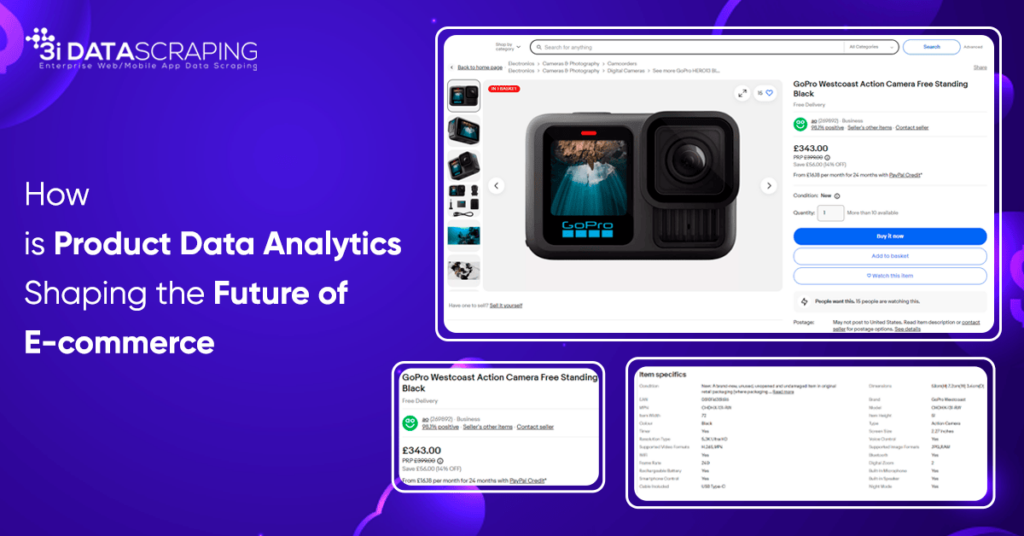 Affiliate Blog Copy – Sell Without Selling. Earn More Now!
Affiliate Blog Copy – Sell Without Selling. Earn More Now!
Product Matching With ML In Retail: The Technology Transforms The Industry
Written by 3i Data Scraping » Updated on: June 17th, 2025

Introduction
The rise of various technologies has brought data-driven businesses into the limelight. With this in mind, retailers and brands strive to transform competitive eCommerce information into intelligent data to boost their success. Data quality has become the primary factor that helps these industries stand out.
Product matching has become an integral part of the retail industry today. Brands and retailers use this technique to compare similar products of other brands and develop an understanding of their prices, products, attributes, and more. It allows them to plan their pricing strategies and improve the customer experience.
Retailers have to remain competitive in this era. Moreover, data streaming from various suppliers and vendors makes it difficult for them to ensure their data quality. Deep learning-based and automated product data scraping solutions have come to the rescue in this scenario. Artificial Intelligence and Machine Learning are the prominent technologies to rise in this era and simplify things.
These technologies have changed the future of the retail industry. Let us discover how Product Matching with ML will benefit retailers.
Product Matching with ML
Artificial Intelligence and Machine Learning have revolutionized multiple horizons. Product Matching is no exception when it comes to leveraging Machine Learning technology. It allows searching for appropriate products and their data on various platforms and web stores. Companies use this data to determine their pricing position in the market. ML algorithms automate the product matching processes with the utmost accuracy in no time.
Types of Product Matching
Retailers use competition-based pricing to remain competitive in the market regarding pricing strategies, promotions, and more. Product Matching allows retailers to compare identical products and prices on other web stores. The comparison involves matching SKUs’ prices, which increases or decreases the current rates aligned with the market.
Barcode Matching: It involves matching product URLs based on ASIN, UPC, or GTIN. The data quality suffers because of the complications involved in verification. The main blocks in the matching process are data inadequacy and confined search capacity.
Manual Matching: The process involves matching products manually. Retailers search for similar products and check if they match. It offers high accuracy. However, it is time-consuming and requires more human resources.
ML-driven Product Matching: It is an automated process of product matching. The process involves using algorithms that speed up the processes and provide a wide range of information that may include several product features. However, this process of product matching has its limitations. It involves cleansing data correctly and requires high-quality datasets for ML model training.
Every Piece of Data Helps
Data in any form helps in determining price strategies. It enables retailers to compare their rates with competitors’ and plan their policies accordingly. They compare different attributes of identical products and get the desired data in the required format.
Product Matching With AI Benefits Retail Businesses
Artificial Intelligence has revolutionized the retail industry by automating product-matching processes. Here, we have listed a few of the significant benefits.
1. It allows the execution of automated promotions and price variations effectively.
2. It helps avoid significant overstocking errors.
3. It offers competitive insights for optimizing product assortments.
4. It helps you measure the actual product performance by giving access to the product lifecycle data.
5. It increases traffic and conversions with improved visibility of product targeting.
Unleash the Key to Retail Domination
A retail strategy consists of three aspects.
Strong Product Data Management Proficiencies
Retail teams get access to scalable, unified, and accurate data sources for sales and products through an ideal product-matching engine. It allows you to develop retail strategies in a structured system aligned with global standards in product taxonomy. As a result, it makes your retail strategies data-powered and competitive.
Unmatching eCommerce Experience

It offers accurate and exact product matches, enhancing product search and customer experience. For example, they deploy Chatbots on eCommerce websites to improve product tagging and categorization. As a result, it improves the efficiency of your product similarity engine.
The increasing popularity of Google Shopping has brought a revolutionary change in how consumers view your products. With product matching, you can align your product descriptions and categorizations with sales performance and historical search. It will, in turn, enhance your search engine performance.
Wise Decisions
Using retail dashboards, you can monitor and compare your products with those displayed on competitors’ websites. It allows you to track exact and identical product matches. Repricing and dynamic algorithms evaluate pricing milestones according to the volume of tracked exact matches. It means that an advanced product-matching technique identifies inconsistent matches across websites.
Product Matching With AI-Driven by Machine Learning
These techniques fairly collect product data. However, they do not address the underlying ‘matching’ abilities and quality hassles. The most common price and product-matching solutions cannot match with the unstable layouts, refined algorithms, and changing rules on leading eCommerce marketplaces. The absence of real-time data refreshes and these criteria are responsible for retail tragedies.
On the other hand, well-planned efforts with manual data aggregation to develop matching algorithms effectively eliminate human errors and biases. Limited scale and size of competitive product tracking further narrow down the vision. Thus, it will result in costly, labor-oriented, and shortsighted retail intelligence.
Product Matching Techniques
Product details on eCommerce platforms include an image, a title, and attributes. A title includes the product’s name, characteristics, and brief details. Attributes offer more information about the product based on name pairing. Take an example of a male plaid shirt.
Retailers can categorize product attributes in structured tables. A male plaid shirt contains attributes like size, color, and information about the manufacturer and fabric. Images explain the appearance of the product. Usually, sellers tend to take the same product images from their competitors.
As a result, it makes it convenient for consumers to identify similar options. However, due to identical images, they are likely to not pay heed to your offer. Let us know how you can fix this bug with product-matching algorithms.
1. Price Comparison
Price similarity includes comparing prices of identical products. For example, in a range of similar products, one offer may stand out from the rest, which means that the product is different. Moreover, with price distribution, you can track identical offers.
Two data analysis algorithms help to detect price similarities.
1. Price outlier detection: It compares one price to similar prices of a group of products. The test comes into the picture when a rate is lower or higher than the pricing of this group.
2. Clustering: It offers insight into the volume of identical products based on price. Product-matching algorithms use these insights to generate outputs.
2. Title Similarity
It is a Machine Learning product-matching solution module. The ML algorithm quantifies the similarity of titles. The comparison strings may differ, but the technology effectively tracks identical titles.
For example, different retailers put the same offer for a brand of a shirt as follows:
1. Name
2. Price
3. Size & Fit
4. Style Type
5. Sleeve
6. Fabric
7. Waistrise
The attributes above will differ in value from seller to seller. However, if you want to identify similar products, you have to select the relevant model. Machine Learning technology implements a specific product-matching algorithm to track sellers’ identical offers. It will further evaluate the resemblance and display similar products in the same search output.
Point-to-point mutual information preprocessing is the first step in the algorithm. Under this process, ML views two different tokens as a single entity. As a result, it will calculate embeddings at the word level. Moreover, it will train word-level embeddings on title data from the entire catalog. With training, ML can accurately manage valuable untrained data.
The technology prevents the errors of word-level details by taking random titles and pairing them with similar ones that do not have tokens. Further, related titles train a convolutional web and determine if the title has an equal length in each section. The skip-gram model accomplishes this purpose.
3. Image Similarity
Image similarity is similar to title similarity. It uses the concept of quantifying image similarity to track identical products. It brings in a challenge when the data points on the product need more labels. Moreover, these images may vary in color, temperature, brightness, perspective, etc. With auxiliary taxonomy to train image-oriented models, you can eliminate the manual processing of image pairs.
4. Attribute Extraction
The attribute extraction involves product matching based on similar product categories; for example, color, model, brand, condition, etc. Moreover, with data analysis algorithms, ML examines the disparity between products. If the discrepancy is low, it considers them to be the same.

1. Retail Landscape Demands Purchase Over Development
As a business analytics unit, keeping up with the evolving algorithms of search engines and marketplaces is impossible.
APIs can be used across diverse teams so that your business is not bogged down with data management and does not require significant investment.
By avoiding blind spots and costly mistakes, saving costs, and eliminating decision paralysis, Product Matching solution helps you save money and reduce costs.
2. Accountability
Product matching is the most challenging part of any business. When you hire product matching services, they are accountable for their task of delivering the output.
Product matching services provide the most comprehensive product-matching service in the industry.
Using AI-powered algorithms that monitor websites worldwide, you can identify and compare similar competitors’ products, whether they are private-label or branded.
3. Hassle-free Onboarding Customizable APIs
Product matching services help you bridge the gap between technical specialists and insight-seeking.
It enables users of several retail teams to expand their access to data across multiple platforms.
Conclusion
A merchant can analyze product matching data for precise product matching by using pertinent data and machine learning. With improvements in machine learning, we can now extract products at a scale never before possible in retail from various sellers, languages, and markets. To maximize the benefits of product matching and increase the company’s value, healthy competitive price data and high-quality datasets are essential for every retailer.
Source: https://www.3idatascraping.com/product-matching-with-ml-transforms-the-retail-industry/
Note: IndiBlogHub features both user-submitted and editorial content. We do not verify third-party contributions. Read our Disclaimer and Privacy Policyfor details.
Copyright © 2019-2025 IndiBlogHub.com. All rights reserved. Hosted on DigitalOcean for fast, reliable performance.













